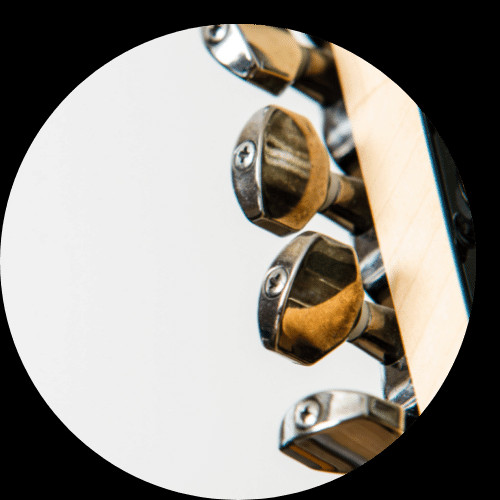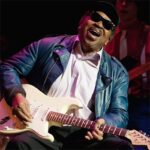Tuning your electric guitar is the very first skill every guitarist needs to master. An out-of-tune guitar can derail band practice, make your playing sound unprofessional, and hinder your musical progress. Thankfully, tuning an electric guitar is a straightforward process that only takes a few minutes once you know how.
If you’re new to the world of guitar playing, the tuning process might seem a bit mysterious. This guide is designed to demystify guitar tuning, offering clear explanations and step-by-step methods to get your electric guitar sounding its best, whether you’re using a tuner or tuning by ear.
Understanding the Basics of Guitar Tuning
Tuning a guitar involves adjusting the pitch of each of its open strings to specific notes. While various guitar tunings exist, each creating a unique sonic landscape (like Drop D for heavier genres or Open G for bluesy tones), standard tuning is the foundation for most musical styles and where every beginner should start.
Standard guitar tuning, from the thickest string to the thinnest, is E-A-D-G-B-e.
 Close up of tuning pegs on an electric guitar headstock
Close up of tuning pegs on an electric guitar headstock
Tuning Pegs: Your Pitch Control
Located on the guitar’s headstock are the tuning pegs, six in total, each connected to a string. These pegs are your primary tool for adjusting string pitch. Turning a tuning peg tightens or loosens the corresponding string.
When a string is sharp (#), it means it’s tuned too high in pitch – the string is too tight. Conversely, a flat (♭) string is too low in pitch – the string is too loose. By carefully rotating the tuning pegs, you can lengthen or shorten the strings, precisely raising or lowering their pitch until they match the correct notes in standard tuning.
Tuning Your Electric Guitar with a Tuner: The Quick and Easy Method
Modern technology has made tuning incredibly accessible. Electronic guitar tuners are accurate, affordable, and incredibly user-friendly, making them ideal for beginners and experienced players alike.
 A guitarist using a clip-on tuner on an electric guitar
A guitarist using a clip-on tuner on an electric guitar
There are several types of guitar tuners available:
- Clip-on Tuners: These attach directly to your guitar’s headstock and detect pitch through vibration. They are convenient and work well even in noisy environments.
- Tuner Pedals: Popular among electric guitarists, these pedals are part of your signal chain and often feature a display that mutes your guitar signal while tuning.
- Tuning Apps: Smartphone apps like Simply Tune utilize your device’s microphone to detect pitch. They are free and readily available.
- Handheld Tuners: These are dedicated electronic tuners, often offering various features and tuning modes.
Regardless of the type you choose, the basic process for tuning with a tuner is the same:
- Power On and Select Standard Tuning: Turn on your tuner and ensure it’s set to standard guitar tuning (E-A-D-G-B-e). Most tuners will default to this or allow you to select it easily.
- Plug In (If Using an App or Pedal): If you are using a tuner app or a tuner pedal, plug your electric guitar into your amplifier (ensure any effects are off for a clean signal) and ensure your guitar is connected to the tuner. Clip-on tuners do not require plugging in.
- Tune String by String: Start with the thickest string (low E string). Pluck the open string. The tuner will register the pitch and indicate whether it’s sharp or flat and how close you are to the correct note.
- Adjust Tuning Pegs: If the tuner indicates the string is flat, turn the corresponding tuning peg to tighten the string, raising the pitch. If it’s sharp, loosen the string to lower the pitch.
- Aim for the Center: Adjust the tuning peg until the tuner indicates you’ve reached the correct pitch (usually a needle pointing to the center or a light turning green).
- Repeat for All Strings: Move on to the next string (A string) and repeat steps 3-5 until all six strings are correctly tuned (E-A-D-G-B-e).
Tuning Your Electric Guitar by Ear (Without a Tuner): Developing Your Musical Ear
While tuners are incredibly helpful, learning to tune your guitar by ear is a valuable skill that enhances your musicality and ear training. It relies on your ability to recognize and match pitches.
Tuning to a Reference Pitch
One way to tune by ear is to use a reference pitch. This could be from:
- A Piano: A piano in tune can provide accurate reference pitches. You can match each guitar string to the corresponding piano keys. (More details on this method can be found in resources like How to Tune a Guitar With a Piano).
- Online Tone Generators or Tuning Forks: You can use online tone generators or tuning forks to provide a starting reference note, often A440 (the A note on the 5th fret of the high E string).
Relative Tuning: Tuning String to String
Relative tuning is a technique where you tune each string in relation to another string that is already in tune. This method relies on knowing the intervals between the strings in standard tuning.
Here’s how to use relative tuning:
- Start with the Low E String (6th String): Ideally, you want your low E string to be close to correct pitch. If you have a reference note (like from a piano or tuning fork), tune your low E string to that. If not, you will be tuning relatively and the overall tuning might be slightly higher or lower than perfect standard pitch, but the guitar will be in tune with itself.
- Tune the A String (5th String) to the Low E String: Press down the low E string at the 5th fret. This fret should produce an A note, the same pitch as the open A string. Pluck the 5th fret of the low E string and then pluck the open A string. Adjust the tuning peg of the A string until it sounds exactly the same as the note you are playing on the 5th fret of the low E string.
- Tune the D String (4th String) to the A String: Press down the A string at the 5th fret. This should produce a D note, the same as the open D string. Tune the open D string to match this pitch.
- Tune the G String (3rd String) to the D String: Press down the D string at the 5th fret. This should produce a G note, the same as the open G string. Tune the open G string to match.
- Tune the B String (2nd String) to the G String: This is the exception. Press down the G string at the 4th fret (not the 5th). This fret should produce a B note, the same as the open B string. Tune the open B string to match this pitch.
- Tune the High E String (1st String) to the B String: Press down the B string at the 5th fret. This should produce a high E note, the same as the open high E string. Tune the open high E string to match this pitch.
For a visual demonstration of relative tuning, resources like this YouTube video can be very helpful.
How Often Should You Tune Your Electric Guitar?
The frequency of tuning depends on several factors, including:
- Playing Intensity and Frequency: Aggressive playing and frequent use will cause your guitar to go out of tune more quickly.
- String Condition: New strings stretch and go out of tune faster initially. Older strings can also lose their elasticity and tuning stability.
- Environmental Changes: Temperature and humidity fluctuations significantly impact a guitar’s tuning. Wood expands and contracts, affecting string tension.
Best Practice: Tune Every Time You Play. Developing the habit of tuning your guitar before each practice session or performance ensures you always sound your best and trains your ear to recognize when your instrument is out of tune. With readily available tuner apps and clip-on tuners, tuning is quick and convenient.
Conclusion: Stay in Tune and Keep Playing!
Tuning your electric guitar is a fundamental skill that unlocks your musical potential. Whether you rely on the precision of an electronic tuner or develop your ear to tune by listening, keeping your guitar in tune is crucial for enjoyable and productive practice sessions. Embrace the tuning process as part of your routine, and you’ll be rewarded with a guitar that sounds great and inspires you to play more!
To further enhance your guitar journey, consider exploring resources like Simply Guitar, an app designed to guide you from the basics to advanced techniques in a fun and engaging way.
FAQs About Tuning Electric Guitars
What are the different types of guitar tuners I can use?
There are several types of tuners, including clip-on tuners (vibration-based), pedal tuners (for pedalboards), smartphone apps (microphone-based), and handheld electronic tuners. Each type has its advantages, choose one that suits your needs and playing style.
Are there guitar tunings other than standard tuning?
Yes, many alternative tunings exist! These tunings alter the intervals between strings, creating different sounds and chord voicings. Popular alternative tunings include Drop D, Open G, and many others, often used in specific genres like metal, blues, or folk music. However, standard tuning (E-A-D-G-B-e) is the essential starting point.
Why does my guitar go out of tune so often?
Guitars go out of tune due to string stretching, temperature and humidity changes, and the physical stress of playing. Regular tuning is a normal part of guitar maintenance. If your guitar goes out of tune very rapidly, you may need to check for issues like worn strings or problems with the tuning pegs or bridge.

